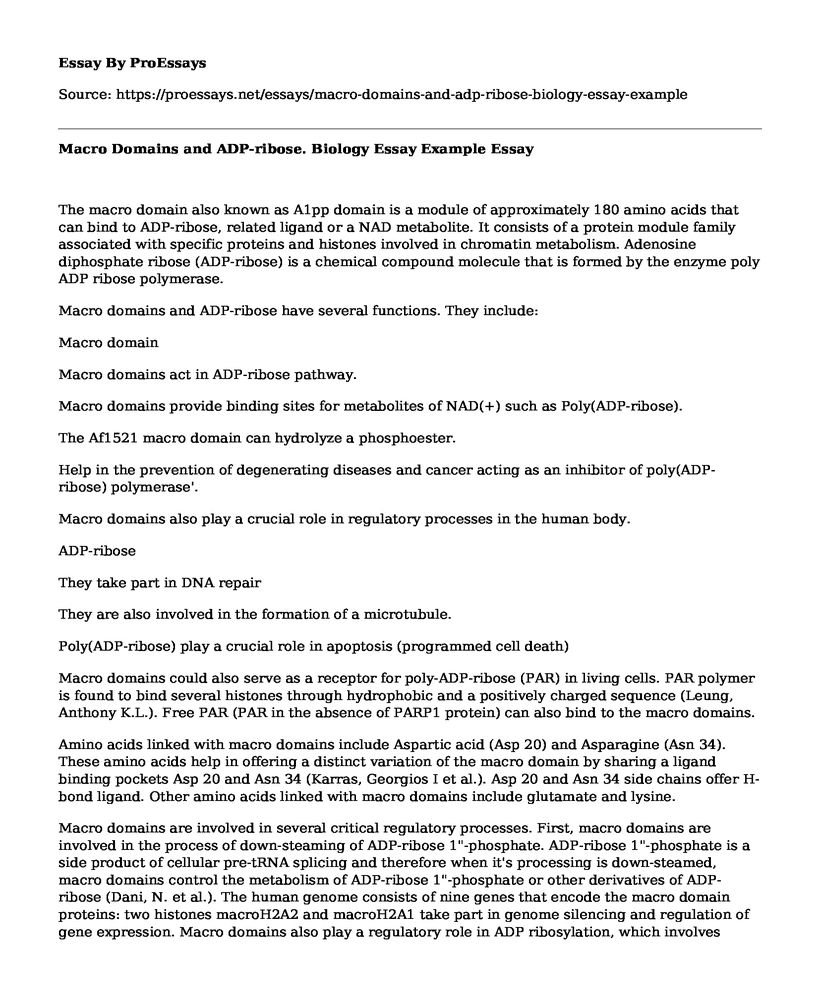The macro domain also known as A1pp domain is a module of approximately 180 amino acids that can bind to ADP-ribose, related ligand or a NAD metabolite. It consists of a protein module family associated with specific proteins and histones involved in chromatin metabolism. Adenosine diphosphate ribose (ADP-ribose) is a chemical compound molecule that is formed by the enzyme poly ADP ribose polymerase.
Macro domains and ADP-ribose have several functions. They include:
Macro domain
Macro domains act in ADP-ribose pathway.
Macro domains provide binding sites for metabolites of NAD(+) such as Poly(ADP-ribose).
The Af1521 macro domain can hydrolyze a phosphoester.
Help in the prevention of degenerating diseases and cancer acting as an inhibitor of poly(ADP-ribose) polymerase'.
Macro domains also play a crucial role in regulatory processes in the human body.
ADP-ribose
They take part in DNA repair
They are also involved in the formation of a microtubule.
Poly(ADP-ribose) play a crucial role in apoptosis (programmed cell death)
Macro domains could also serve as a receptor for poly-ADP-ribose (PAR) in living cells. PAR polymer is found to bind several histones through hydrophobic and a positively charged sequence (Leung, Anthony K.L.). Free PAR (PAR in the absence of PARP1 protein) can also bind to the macro domains.
Amino acids linked with macro domains include Aspartic acid (Asp 20) and Asparagine (Asn 34). These amino acids help in offering a distinct variation of the macro domain by sharing a ligand binding pockets Asp 20 and Asn 34 (Karras, Georgios I et al.). Asp 20 and Asn 34 side chains offer H-bond ligand. Other amino acids linked with macro domains include glutamate and lysine.
Macro domains are involved in several critical regulatory processes. First, macro domains are involved in the process of down-steaming of ADP-ribose 1"-phosphate. ADP-ribose 1"-phosphate is a side product of cellular pre-tRNA splicing and therefore when it's processing is down-steamed, macro domains control the metabolism of ADP-ribose 1"-phosphate or other derivatives of ADP-ribose (Dani, N. et al.). The human genome consists of nine genes that encode the macro domain proteins: two histones macroH2A2 and macroH2A1 take part in genome silencing and regulation of gene expression. Macro domains also play a regulatory role in ADP ribosylation, which involves Intra- and intercellular signaling, DNA repair pathway, cell proliferation and differentiation, apoptosis and necrosis, telomere dynamics and transcription regulation.
MacroH2A non-histone domain inhibits poly(ADP-ribose) polymerase' (PARP). This inhibition leads to the prevention or treatment of tissue damage resulting from ischemia and reperfusion injury; it prevents or treats vascular stroke; it prevents cardiovascular disorders. It prevents cancer and also degenerative diseases of the skeletal muscles that involve replicable senescence.
Macro domains exert its activity of regulation in the nucleus, where it regulates the correct assembly of transcriptional complexes. Chromatins containing macroH2A1 that has been assembled in vitro is more repressive to transcription than canonical chromatin and therefore it specifically blocks transcriptional initiation.
Macro domains are found in a variety of bacteria, eukaryotes, and archaea. Their names refer to the non-histone domain of the histone macroH2A. Macro domains are in some instances found to be physically associated with proteins involved in ADP-ribosylation or poly (ADP-ribose) polymerization and also in ATP-dependent chromatin. Macro domains take part in the replication of positive-strand RNA viruses such as rubella virus, alphaviruses (family Togaviridae), hepatitis E virus (HEV) (Egloff, M.-P. et al.). Macro domains are also embedded in the polyprotein of the three viral families, Togaviridae, Coronaviridae, and Hepeviridae and reverse cellular ADP-ribosylation, therefore, cutting the signal of the viral infection in the cell.
Work Cited
Dani, N. et al. "Combining Affinity Purification By ADP-Ribose-Binding Macro Domains With Mass Spectrometry To Define The Mammalian ADP-Ribosyl Proteome". Proceedings Of The National Academy Of Sciences, vol 106, no. 11, 2009, pp. 4243-4248. Proceedings Of The National Academy Of Sciences, doi:10.1073/pnas.0900066106.
Egloff, M.-P. et al. "Structural And Functional Basis For ADP-Ribose And Poly(ADP-Ribose) Binding By Viral Macro Domains". Journal Of Virology, vol 80, no. 17, 2006, pp. 8493-8502. American Society For Microbiology, doi:10.1128/jvi.00713-06.
Karras, Georgios I et al. "The Macro Domain Is An ADP-Ribose Binding Module". The EMBO Journal, vol 24, no. 11, 2005, pp. 1911-1920. Wiley-Blackwell, doi:10.1038/sj.emboj.7600664.
Leung, Anthony K.L. "Poly(ADP-Ribose): An Organizer Of Cellular Architecture". J Cell Biol, vol 205, no. 5, 2014, pp. 613-619. Rockefeller University Press, doi:10.1083/jcb.201402114.
Cite this page
Macro Domains and ADP-ribose. Biology Essay Example. (2021, Mar 26). Retrieved from https://proessays.net/essays/macro-domains-and-adp-ribose-biology-essay-example
If you are the original author of this essay and no longer wish to have it published on the ProEssays website, please click below to request its removal:
- Research Paper on Methods for Treating Muscle Tissue Loss
- Essay Sample on Endangered Species: Gray Wolf
- Essay Sample on Anatomic Planes in the Body of a Human Being
- Integumentary and Skeletal System - Research Paper
- The Gluteus Maximus: A Powerful Muscle for Upright Posture - Essay Sample
- Saving the Bees: The Need for Animal Protection and Preservation - Research Paper
- Explore the Depths of the Ocean: Oceanography and Its Benefits - Essay Sample







